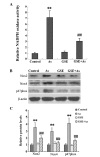Grape seed extract attenuates arsenic-induced nephrotoxicity in rats
- PMID: 24348802
- PMCID: PMC3861237
- DOI: 10.3892/etm.2013.1381
Grape seed extract attenuates arsenic-induced nephrotoxicity in rats
Abstract
Oxidative stress is a recognized factor in nephrotoxicity induced by chronic exposure to inorganic arsenic (As). Grape seed extract (GSE) possesses antioxidant properties. The present study was designed to evaluate the beneficial effects of GSE against arsenic-induced renal injury. Healthy, male Sprague-Dawley rats were exposed to As in drinking water (30 ppm) with or without GSE (100 mg/kg) for 12 months. The serum proinflammatory cytokine levels and mRNA expression levels of fibrogenic markers in the renal tissues were evaluated using enzyme-linked immunosorbent assay and quantitative polymerase chain reaction, respectively. The protein expression levels of nicotinamide adenine dinucleotide phosphate (NADPH) subunits, transforming growth factor-β1 (TGF-β1) and phosphorylated Smad2/3 (pSmad2/3) were assessed using western blot analysis. The results demonstrated that cotreatment with GSE significantly improved renal function, as demonstrated by the reductions in relative kidney weight (% of body weight) and blood urea nitrogen, and the increase in the creatinine clearance capacity. GSE attenuated the As-induced changes in the serum levels of tumor necrosis factor-α (TNF-α), interleukin-6 (IL-6) and IL-1β and the mRNA levels of TGF-β1, α-smooth muscle actin (α-SMA), connective tissue growth factor (CTGF) and fibronectin (FN) in renal tissue. Furthermore, administration of GSE markedly reduced As-stimulated reactive oxygen species (ROS) production and Nox activity, as well as the protein expression levels of the NADPH subunits (Nox2, p47phox and Nox4). In addition, GSE cotreatment was correlated with a significant reduction in TGF-β/Smad signaling, as demonstrated by the decreased protein levels of TGF-β1 and pSmad2/3 in renal tissue. This study indicated that GSE may be a useful agent for the prevention of nephrotoxicity induced by chronic exposure to As. GSE may exert its effects through the suppression of Nox and inhibition of TGF-β/Smad signaling activation.
Keywords: NADPH oxidase; TGF-β/Smad; chronic arsenic exposure; grape seed extract; nephrotoxicity; oxidative stress.
Figures



Similar articles
-
Inhibition of arsenic-induced rat liver injury by grape seed exact through suppression of NADPH oxidase and TGF-β/Smad activation.Toxicol Appl Pharmacol. 2011 Aug 1;254(3):323-31. doi: 10.1016/j.taap.2011.04.022. Epub 2011 May 13. Toxicol Appl Pharmacol. 2011. PMID: 21605584
-
NAD(P)H oxidase mediates TGF-beta1-induced activation of kidney myofibroblasts.J Am Soc Nephrol. 2010 Jan;21(1):93-102. doi: 10.1681/ASN.2009020146. Epub 2009 Nov 19. J Am Soc Nephrol. 2010. PMID: 19926889 Free PMC article.
-
Renal protective effects of arjunolic acid in a cisplatin-induced nephrotoxicity model.Cytokine. 2016 Jan;77:26-34. doi: 10.1016/j.cyto.2015.10.010. Epub 2015 Oct 27. Cytokine. 2016. PMID: 26517155
-
Induction of renal fibrotic genes by TGF-β1 requires EGFR activation, p53 and reactive oxygen species.Cell Signal. 2013 Nov;25(11):2198-209. doi: 10.1016/j.cellsig.2013.07.007. Epub 2013 Jul 18. Cell Signal. 2013. PMID: 23872073
-
Protective effects of Salvia miltiorrhiza on adenine-induced chronic renal failure by regulating the metabolic profiling and modulating the NADPH oxidase/ROS/ERK and TGF-β/Smad signaling pathways.J Ethnopharmacol. 2018 Feb 15;212:153-165. doi: 10.1016/j.jep.2017.09.021. Epub 2017 Oct 12. J Ethnopharmacol. 2018. PMID: 29032117
Cited by
-
Circulating Arsenic is Associated with Long-Term Risk of Graft Failure in Kidney Transplant Recipients: A Prospective Cohort Study.J Clin Med. 2020 Feb 3;9(2):417. doi: 10.3390/jcm9020417. J Clin Med. 2020. PMID: 32028652 Free PMC article.
-
Alteration in thiols homeostasis, protein and lipid peroxidation in renal tissue following subacute oral exposure of imidacloprid and arsenic in Wistar rats.Toxicol Rep. 2018 Nov 3;5:1114-1119. doi: 10.1016/j.toxrep.2018.11.003. eCollection 2018. Toxicol Rep. 2018. PMID: 30456172 Free PMC article.
-
Grape seed powder improves renal failure of chronic kidney disease patients.EXCLI J. 2016 Jun 27;15:424-433. doi: 10.17179/excli2016-363. eCollection 2016. EXCLI J. 2016. PMID: 27822171 Free PMC article.
-
Nephroprotective effect of magnesium isoglycyrrhizinate against arsenic trioxide-induced acute kidney damage in mice.Exp Ther Med. 2022 Apr;23(4):276. doi: 10.3892/etm.2022.11202. Epub 2022 Feb 11. Exp Ther Med. 2022. PMID: 35317438 Free PMC article.
-
The Role of Reactive Oxygen Species in Arsenic Toxicity.Biomolecules. 2020 Feb 5;10(2):240. doi: 10.3390/biom10020240. Biomolecules. 2020. PMID: 32033297 Free PMC article. Review.
References
-
- Bao L, Shi H. Potential molecular mechanisms for combined toxicity of arsenic and alcohol. J Inorg Biochem. 2010;104:1229–1233. - PubMed
-
- Eom SY, Lee YC, Yim DH, Lee CH, Kim YD, Choi BS, Park CH, Yu SD, Kim DS, Park JD, Kim H. Effects of low-level arsenic exposure on urinary N-acetyl-β-D-glucosaminidase activity. Hum Exp Toxicol. 2011;30:1885–1891. - PubMed
-
- Chen JW, Chen HY, Li WF, Liou SH, Chen CJ, Wu JH, Wang SL. The association between total urinary arsenic concentration and renal dysfunction in a community-based population from central Taiwan. Chemosphere. 2011;84:17–24. - PubMed
-
- Kitchin KT. Recent advances in arsenic carcinogenesis: modes of action, animal model systems, and methylated arsenic metabolites. Toxicol Appl Pharmacol. 2001;172:249–261. - PubMed
LinkOut - more resources
Full Text Sources
Other Literature Sources
Research Materials
Miscellaneous
